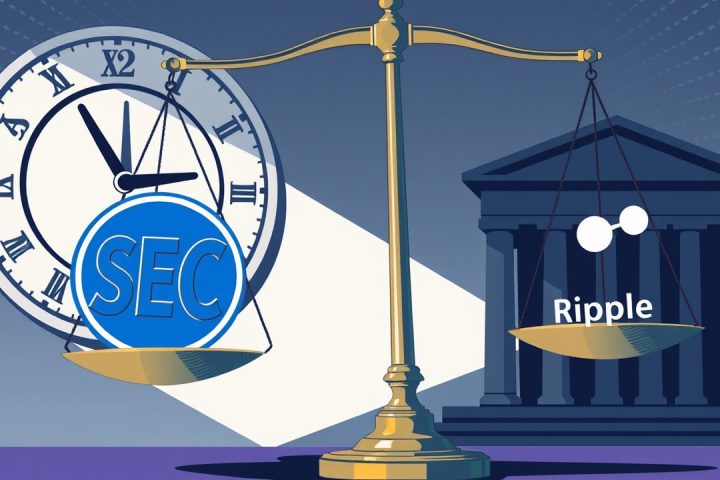Statement Summary
In a recent speech, SEC Commissioner highlighted the historical resilience of London, particularly its recovery from the Great Fire of 1666 and WWII bombings, serving as a metaphor for enduring financial partnerships between the UK and the US. The Commissioner proposed the idea of a cross-border regulatory sandbox, aimed at fostering innovation in financial markets, particularly concerning blockchain and crypto technologies. This sandbox would allow financial firms to experiment across both jurisdictions under a unified set of regulatory conditions, enhancing cooperation between the SEC and UK regulators. The initiative seeks to support a robust, interconnected financial system benefiting investors and innovators while promoting effective market regulation. The overarching goal is to leverage shared regulatory principles to drive global market resilience and economic collaboration.
Original Statement
Thank you, Chairman [Chris] Hayward. You have once again gone out of your way to make me feel welcome in London. Thank you also to all of you who are here today. Before I begin, I must remind you that my views are my own as a Commissioner of the United States Securities and Exchange Commission and not necessarily those of the SEC or my fellow Commissioners or of anyone else in U.S. Government.
It is an honor to stand before you in this grand and historic room. The Guildhall is a symbol of resilience—the site is rich with centuries of history that enliven a vibrant present—and renewal—when fire or war has damaged the place, reconstruction followed. Notably, the Guildhall survived London’s Great Fire of 1666, though not fully intact. Samuel Pepys, the go-to eyewitness of the fire that burned much of London to the ground, described watching “the fire grow . . . in a most horrid malicious bloody flame” so that it “made [him] weep to see it.” Although the fire’s official death toll was remarkably low at six people, the four-day conflagration caused years of immeasurable human suffering for an overwhelmingly homeless, and universally, haunted population. Pepys, whose house survived the blaze—as presumably did the Parmesan cheese he had buried before fleeing the oncoming flames—remarked a few days after the fire that he “sleeping and waking had a fear of fire in my heart” and in 1667 still could not “sleep at night without great terrors of fire.” Rebuilding began right away but took decades to complete. In December 1667, Pepys observed that “the city [had] got a pace on in the rebuilding of Guildhall.”
As with any large-scale reconstruction, conflicting architectural plans, regulatory uncertainty, and legal wrangling about how to rebuild and who foots the bill sometimes slowed progress. But, with the help of its financial markets, the city rebuilt itself from the ashes, this time with less flammable materials. London’s ability to survive and thrive after the Great Fire served as a precedent for its later perseverance through and recovery from the ravages of World War II bombings of the city. Pepys was not around to document those events, but photographic evidence tells of the destruction and suffering in a way that words could not. Photos of the post-air-raid Guildhall reveal a pile of rubble against a still-standing grand backdrop. Again, London rebuilt the Guildhall and the rest of itself from its bombed ruins into a thriving metropolis. The United States through the Marshall Plan and other measures helped to finance that effort. That assistance, a continuation of the wartime alliance, is evidence of a relationship that runs deep between our nations.
Physical manifestations of that connection exist in the damaged London church that was reconstructed as a memorial to Winston Churchill in Missouri and in the bomb detritus that was shipped from the United Kingdom in empty aid ships returning to the United States and used to build parts of New York City. The US-UK bond also reveals itself in the intertwining of our markets for human talent, capital, physical goods, and services, including financial services.
Regulatory Cooperation and Innovation
Smart financial regulation embraces and perpetuates the knitting together of our two nations. Because we share so many of the same principles, the United Kingdom is a natural partner with the United States in the endeavor to foster resilient and robust global capital markets. We have a long history of working together. We both have common-law systems that afford strong legal protections to investors. We share an appreciation for the role capital markets play in empowering our people to build a vibrant, prosperous society. We both recognize the importance of market-driven capital allocation decisions in ensuring that society builds the right things and builds them well. We both acknowledge the importance of innovation and competition in serving people’s needs.
Both jurisdictions value an environment in which incumbents and new entrants can try new things and change the way old systems work. Both jurisdictions, by promulgating and implementing generally sensible and properly focused regulatory frameworks, have fostered capital markets that attract global investors and talent. Shared principles alone are not enough to bind our markets together. Regulatory cooperation, which takes many forms, helps too. I have benefited on this trip, for example, from bilateral meetings with my UK counterparts, and similar meetings happen frequently between UK and US officials.
Supervisory colleges bring regulators and supervisors together to compare notes on multinational market participants. Substituted compliance—a tool we have used in security-based swaps regulation—enables a market participant that meets one jurisdiction’s regulatory requirements to satisfy the rules of the other jurisdiction geared toward a similar objective. UK and US regulators have worked together to overcome data access challenges to clear the way for US examinations of the more than 270 UK investment advisers serving clients in the US and for additional UK advisers to join their ranks. UK and US authorities also routinely cooperate on enforcement matters by, for example, facilitating one another’s investigations of potential securities law violations.
Cross-Border Regulatory Sandbox
Just over a year ago, I suggested another tool for regulators to use in bringing our markets together. In a comment letter to the Bank of England and the Financial Conduct Authority on their consultation on a digital securities sandbox, I suggested a cross-border sandbox. The UK government had proposed a digital securities sandbox, which was limited to UK firms, to generate real-world insights about whether distributed ledger technology could streamline the issuance, trading, and settlement of securities without undermining investor protection, market integrity, or financial stability. I posited that a cross-border version of the sandbox could be even more effective: innovators could benefit from simultaneously serving UK and US markets; regulators, relying on information sharing agreements, could benefit by seeing more data on how complex emerging technologies operate in different contexts; and the British and American public could benefit by being served by a greater pool of product and service providers.
As I envisioned it, a very flexible US micro-innovation sandbox would pair well with a UK sandbox; participants could adhere to a single set of conditions in both jurisdictions. Details matter, and I ended the letter by welcoming a discussion on how we might bring a cross-border sandbox to life. I have appreciated expressions of interest from the public and private sector in the UK, including much useful feedback gathered by Chairman Hayward and his colleagues at the City of London. Several months ago, referring to my sandbox, Chancellor Reeves advocated “explor[ing] opportunities to support industry to innovate cross-border . . . potentially allowing greater digital collaboration between capital markets in New York and London.” And at last night’s Mansion House Speech, Chancellor Reeves reiterated her support for “proposals for greater digital collaboration between our two financial centres.”
The goal of future conversations between our two jurisdictions should be a financial system better able to serve UK and US investors, innovators, and entrepreneurs. A sandbox can serve as a bridge between our current rulebooks and future financial markets by allowing people to experiment with technology that may underpin the markets of the future.
Key Considerations for the Sandbox
As I have thought more about the sandbox idea in the past year and talked with others, several themes have emerged. First, perhaps the term “sandbox” undersells the efficacy of the tool. “Sandbox” describes a regulatory mechanism that the UK and other jurisdictions have put to productive use. Yet the term evokes for some an isolated laboratory environment with no prospect of long-term commercialization and for others children at play. Innovators are childlike only in their healthy sense of curiosity, which enables them to identify and solve societal problems.
As I have said before, beaches are better than sandboxes. Beaches give innovators more room to formulate and reformulate ideas within eyeshot of the regulator—in this analogy the lifeguard—but lifeguards do not opine every time a beachgoer adds a turret to her sandcastle, as a regulator sitting in a sandbox with the innovator might be tempted to do. Despite its appeal to this freedom-lover, “cross-border beach” is unlikely to catch on as a term. Maybe we can come up with another descriptor such as technology incubator, but meanwhile we are stuck with “sandbox.”
Second, a sandbox has limited utility unless it comes with a smooth exit ramp that takes the participant into a workable permanent regulatory environment. Incorporating an effective exit ramp facilitates commercial experiments that lead to better, cheaper products and services and a more resilient and efficient financial market infrastructure.
Third, and related, a sandbox with time, customer, or activity limits, absent a nimble mechanism to extend the timeline or raise the limits, could put sand in the gears of a growing company or even bring it to a screeching halt. After a period of slow and steady growth, user interest might spike suddenly. If a regulator were not able to react quickly, the company would have to turn new users away, which could color adversely the public’s perception of the company. Similarly, regulators must stand ready to work with participants to change conditions as needed. As part of the standard innovation process, a team may start with one idea and pivot in response to market demand.
Fourth, incumbent firms and new entrants should have equal access to the sandbox. Some observers worry that if entry criteria are not transparent, the sandbox could become a mechanism for regulators to pick winners. Everyone should be able to participate on the same terms, but the whole point of a sandbox is to accommodate experimentation with different ways of doing things. Transparent terms available to everyone with an option to iterate may address this concern. In operating a sandbox, regulators also must be cognizant of the cost of participating, which can be prohibitive for small entities or even for large firms if long-term commercialization is not a reality. A proactive invitation to firms of all shapes, ages, and sizes to come in and talk about whether the sandbox is right for them can help not only to combat perceptions of favoritism, but to build trust, and inform regulators of market developments.
Fifth, regulators cannot force participants into a sandbox. A cross-border sandbox only makes sense if it streamlines the road to commercial viability for a company that wants to serve both the UK and the US. Sandbox projects need to be organically generated, not planned by government working groups. As London found out in rebuilding after the 1666 fire and after the wartime firebombing, grand plans drawn up by experts often give way to organic building in response to real and immediate human needs. Operationalization of a sandbox may have to wait until a company with a concrete idea for cross-border activity approaches both regulators, though I look forward to preparatory discussions in the meantime, including joint discussions with firms and both sets of regulators in the same room.
Sixth, the conditions imposed by a cross-border sandbox would need to be workable for both jurisdictions. For example, I would not support conditioning a sandbox on sustainability or diversity objectives. Extracting conditions unrelated to—and potentially distracting from—the safe and effective functioning of the project would be an improper use of financial regulation to achieve political outcomes.
Seventh, although not a new thought, many people have underscored the importance of protecting investors and markets from harm caused by sandbox activities. These objectives align with the SEC’s mission, but an often-forgotten part of protecting investors and markets is ensuring that new competitors, products, services, and ways of doing things can come into the market. A sandbox constrains, but does not eliminate, risk, which is consistent with sound regulation. As Chancellor Reeves noted last night, regulation can “go too far in seeking to eliminate risk.”
Conclusion
Much of my thinking about a potential sandbox has been in connection with crypto. Blockchain technology, given its early stage and potential for transforming the way our financial system and perhaps other systems work, is ripe for experimentation. The SEC’s Crypto Task Force has received written comment on the issue of sandboxes. The topic of fostering experimentation also comes up in some of the Task Force’s meetings with the public. Market participants are looking to experiment with bitcoin and other crypto assets, stablecoins, non-fungible tokens, digital identity solutions, collateral management, and tokenization of securities and assets such as real estate, among other issues. Blockchain allows for increased transparency, enhanced efficiency, lower costs, increased liquidity, and decentralization. In recent years, many use cases for the technology likely remained unexplored in the face of regulatory hostility or died in the labyrinth of regulatory ambiguity before they could achieve commercial success.
The unique challenges and opportunities raised by blockchain technology and crypto assets and their borderless nature would lend themselves well to a mechanism for facilitating experiments and could help to identify where and how existing regulations might need to change in response. Because market participants are exploring numerous models, a sandbox for tokenizing securities might make sense. Building in cross-border interoperability will be easier now than later when business models have matured. I head back to the US today with the hope that the Crypto Task Force can collaborate with the FCA in coordination with our domestic colleagues across the government and in the context of the Administration’s broader cooperation with the United Kingdom.
Because I prize the ability of capital to flow to its highest and best use, regardless of borders, and of investors to share in the wealth created by entrepreneurs all over the world, I also hope that our cross-jurisdiction partnership can serve as an example of how more than just our two nations can align interests in pursuit of a freer and more prosperous society. Fundamental differences in approaches to and objectives of financial regulation, however, could impede such efforts. Securities markets are key to solving all manner of problems, but only if market participants are free to respond to market incentives rather than serving as robotic mercenaries in a government-orchestrated initiative to achieve objectives unrelated to investor protection, efficiency, competition and capital formation.
As Europe’s embrace of double materiality in corporate reporting and export of its sustainability disclosure requirements have laid bare, market integration suffers when two jurisdictions diverge on core matters such as the purpose of financial statements and other securities disclosures.
On a related note that may be relevant to some people in the room, the SEC recently asked for comment on the definition of a Foreign Private Issuer (“FPI”), which provides a number of specific accommodations from which eligible FPIs may currently benefit as compared to domestic issuers. One of the few comments to date came from an FPI based in the UK urging us “to consider carve-outs or refined eligibility criteria that preserve FPI status for companies with genuine foreign governance and infrastructure, regardless of shareholder geography or incorporation jurisdiction.” That first-hand perspective is valuable, and I look forward to hearing from other interested members of the public, including UK companies, on this topic with similar or differing views.
Thank you for indulging me today with your attention. I hope that the coming months will bring continuing discussions about how people from our two countries can work together for our mutual prosperity and benefit. Cross-border cooperation, whether in the context of crypto or capital markets, is a good way to fan the flames of our long friendship.




